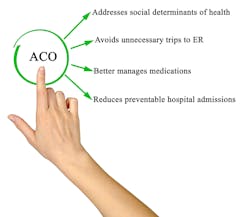Nathan Moore, M.D., medical director of the BJC Medical Group ACO in St. Louis, sees annual wellness visits (AWVs) as a scaffolding for all of the ACO’s improvement efforts. “We're using this as our point of entry for advanced care planning and for functional status evaluations,” he said.
Moore was speaking during an April 28 panel at the NAACOS spring meeting about how ACOs are using AWVs to improve their quality efforts as well as the accuracy of their coding for risk adjustment and billing purposes. As part of the annual wellness visit, patients have to answer 20 questions about their functional status and social determinants of health, Moore noted. “That data just sits there in the EMR and we don't do anything with it. But that's a treasure trove of data that could be used in a variety of other efforts — enrolling patients in remote monitoring for chronic disease management, home-based palliative care. So we're using the AWV as a platform for all of our other efforts at this point.”
All three ACO leaders speaking on the panel described overcoming barriers to increasing AWV completion rates by primary care practices. One of the big barriers that BJC found was that was that denial rates traditionally had been very high for an AWV because they were submitting the wrong codes, or patients had gone to a community health fair to get their blood pressure checked, and while there, somebody did a stealth AWV on them and billed for it and the patient didn't know. He said they started using C-SNAP, which is a free website provided by CMS where staff can log in, put in the patient’s Medicare ID and see when their last AWV was done by anybody in the country and what code can be used at what date in the future. When the patient either was scheduled or preferably showed up for their appointment, the front-desk staff would check the C-SNAP to make sure that they were actually due for the AWB, and denial rates went down significantly.
Among several other steps, BJC also added a health maintenance topic in Epic showing the date of their last well visit or physical exam.
“We were successful in getting up from 40 percent to 70 percent AWVs in our first year after go live and we've been able actually to maintain that rate in the past two years,” Moore said. They are also doing an analysis to see what the true impact has been on spending, utilization and quality. “We haven't seen much impact on utilization on spending,” he said. “It's not surprising. Preliminary data shows a significant increase in the number of PCP visits, and a decrease in avoidable ER visits and readmissions.”
Whitney Denin, R.N., clinical coordinator for the Nebraska Health Network in Omaha, says when explaining the value of AWVs to clinics, she always starts with the patient benefit, including strengthening the relationship, “because this visit is really the time and space that the patient gets to talk to that provider about things that they don't get to during a regular evaluation and management visit,” she says. “It gives them the time to talk about their health goals and wishes, so it makes us aware and it makes their family aware of things that they didn't know. The AWV allows for the identification of gaps in care by reviewing what providers are taking care of the patient’s medication and screenings, and making sure that that either a specialist or PCP has a pulse on the overall care of the patient.”
When Nebraska Health Network started a focused AWV improvement initiative in 2017, its completion rate was around 29 percent. “As of the last update through February 2022, we were at 69 percent,” Denin said. Noting that the value-based performance advisory committee of the ACO is rewarding clinicians for higher completion rates, she said they may get to 70 percent this year.
James Barr, M.D., vice president of clinical intelligence at Atlantic Health System in New Jersey, said that AWVs are a phenomenal place to build the trust and respect that retain a patient for the ACO. “If you ask me what's the No. 1 value that the AWV can deliver, I'm not going to say a better A1c level or better blood pressure,” he said. “The No. 1 value is a chance for the physicians and the advanced practitioners to develop that trust and respect relationship with that patient.”
It can't be viewed as merely a transaction, he added. “This is one of the most challenging things I think we have to take on,” Barr said. “I've seen physician practices that have gotten up to 80 percent on their annual wellness visits, and there's no difference in their outcomes. If it's just a transaction and you're looking to fulfill certain checkmarks, you produce no value out of that. An annual wellness visit requires listening, empathy, emotional intelligence, caring," he stressed. "The patients don't really care what you know, until they know that you care, so our motto at our ACO is to care better.”


